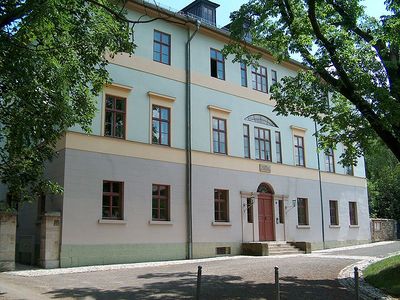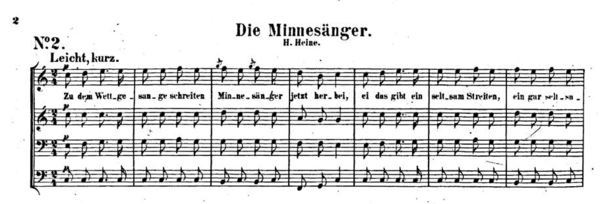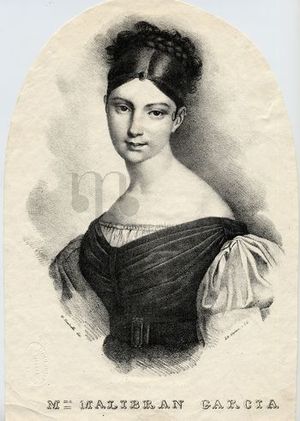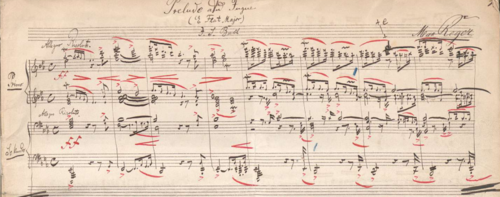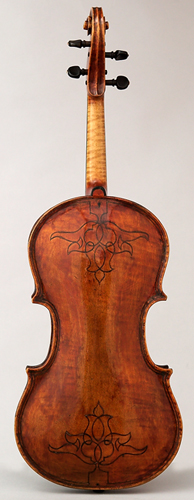Difference between revisions of "Links for Digital Musicology"
| Line 89: | Line 89: | ||
This University of North Carolina website holds more than 3,500 digitized pieces from the 1830s through the end of the nineteenth century. Accompanying catalogue records support searches by topic as well as composer. Holdings range from piano pieces and songs with piano accompaniment to duets, trios, and four-part glees. Miscellaneous material that forms part of the collection includes letters. | This University of North Carolina website holds more than 3,500 digitized pieces from the 1830s through the end of the nineteenth century. Accompanying catalogue records support searches by topic as well as composer. Holdings range from piano pieces and songs with piano accompaniment to duets, trios, and four-part glees. Miscellaneous material that forms part of the collection includes letters. | ||
| − | [[File:AlexRT_Duke.PNG|275px|thumb|left|<small> | + | [[File:AlexRT_Duke.PNG|275px|thumb|left|<small>[http://library.duke.edu/digitalcollections/hasm_a5378/ "Alexander's Ragtime Band"], Historic American Sheet Music, Duke University, Item a5378.</small>]] |
====Durham, NC: Historic American Sheet Music==== | ====Durham, NC: Historic American Sheet Music==== | ||
Revision as of 01:19, 3 September 2014
This wiki provides links to substantial projects of use to musicologists, particularly those involved with digital editions, music encoding, and topic-specific resources. Further resources can be found at ADAM (Archive of Digital Applications in Musicology), for projects that are no longer maintained, and EVE (Electronic and Virtual Editions), for digitally curated (freely downloadable) editions.
Contents
- 1 Musical Repertories: Digital Reprints
- 2 Musical Repertories: Digitized Manuscripts
- 3 Musical Repertories: Digitized Part-books and Choir Books
- 4 Databases (structured)
- 4.1 By Repertory
- 4.1.1 Secular Vocal and Folksong Repertories
- 4.1.1.1 CLORI: Archive of the Italian Cantata
- 4.1.1.2 VolksLiedWerke (Austrian Folksong Database
- 4.1.1.3 Deutsche Volksiedarchiv (German Folksong Archive)
- 4.1.1.4 English Broadside Ballad Archive
- 4.1.1.5 Old English Songs
- 4.1.1.6 Recercar (Chanson Database)
- 4.1.1.7 Goldberg Stiftung: Loire Valley Chanson Sources
- 4.1.2 Sacred and Liturgical Music
- 4.1.3 Liber Usualis
- 4.1.4 Instrumental Music
- 4.1.5 Instrument Makers
- 4.1.1 Secular Vocal and Folksong Repertories
- 4.2 Composer/Theorist Documentation
- 4.3 Digitized Manuscripts and Early Printed Music
- 4.4 Online Thematic Indices
- 4.5 Digital Image Archives
- 4.6 Resources for Chronology
- 4.7 Libretto Portals
- 4.8 Digitized Music Bibliographies
- 4.1 By Repertory
- 5 Portals and Search Engines for Music
- 6 Music Theory Resources
- 7 Historical Maps
- 8 Newspapers
- 9 Music Magazines
- 10 Other Resources of general interest
Musical Repertories: Digital Reprints
By Composer
Ludwig van Beethoven
Website: Ludwig van Beethgovens Werke
The first collected edition of Beethoven's music was published by Breitkopf & Härtel, in Leipzig, between 1862 and xx. This set contains 269 titles. Symphonies, concertos, chamber music, Lieder, folksong arrangements, and much more.
Georg Fr. Handel
Website: Georg Friedrich Händels Werke
The Handel Gesellschaft edition of the composer's works (105 titles) was published by Breitkopf & Härtel between 1985 and 1902. It contains all but a few of the major works known today, sometimes with variants of arias or choruses that were excluded in later editions.
Franz Lizst
Website: Liszt's Musikalische Werke
This collected edition of Franz Liszt's works (35 volumes) was published by Breitkopf & Härtel, Leipzig. Although the first volume appeared in 1870, the others appeared between 1900 and 1936. Symphonies, symphonic poems, works for piano and orchestra, Liszt's music criticism, and little-known arrangements are included. The picture at the left shows Liszt's residence from 1848 to 1861, while he was director of court music. Today the Liszt Haus serves at a museum.
Felix Mendelssohn
Website: Felix Mendelssohn Bartoldys Werke
This collected edition (162 titles) of Mendelssohn's music was issued by Breitkopf & Härtel between xx and yy. String quartets, quintets, chamber music for clarinet and basset horn, piano trios, works for piano and cello, a fantasy on the Irish song "The last rose of summer" (Op. 15) and many other little-known pieces of chamber music can be found here together with more familiar fare.
Wolfgang Amnadeus Mozart
Website: Neue Mozart Ausgabe
A fully digitized version of the Neue Mozart Ausgabe has been available online since 2006. Series and volumes follow exactly the Bärenreiter print. All elements of the printed exemplars (table of contents, score, critical report) are present. Letters, documents, and libretti will be added by the [me.mozarteum.at/DME/main/index.php Digital Mozart Edition] at the Mozarteum, Salzburg, in cooperation with the Packard Humanities Institute. This is the only current collected edition of the works of a major composer offered online at this time.
Ignaz Pleyel Early Editions
Website: Ignaz Pleyel Early Editions
The late musicologist Rita Benton made an exhaustive study of Pleyel's editions (c. 1800) of the early string quartet literature. In the library named after her more than 200 early editions and manuscripts give some sense of the scope of Pleyel's career as both a composer and a music publisher in the era of Haydn, Boccherini, and other notable composers of chamber music. In editions to chamber music for strings Pleyel also brought out piano pedagogy books and piano trios.
Franz Schubert
Website: Franz Schuberts Werke
The collected works of Frans Schubert, as published by Breitkopf & Härtel, Leipzig, 1984-1892. 53 volumes, including symphonic and piano works, choral works, theater pieces, piano four-hands arrangements, and song cycles.
Robert Schumann
Website: Robert Schumanns Werke
The works as edited by Clara Schumann and others. This series was published in Leipzig by Breitkoft & Härtrel between 1881 and 1893. The illustration shows the start of "Die Minnesänger" for four male voices, No. 2 from Schumann's Sechs Leider.
By Collection
Denkmäler Deutscher Tonkunst, 1st series
Monuments of German Music, Series 1
This first anthology of German music of the seventeenth and eighteenth centuries greatly increased familiarity with the music of Buxtehude, Telemann, J. Ch. F. Bach, Franck, Hasse, Scheidt, Stolzler, and many others. These 53 volumes were published in xx.
Denkmäler Deutscher Tonkunst, 2nd series (Bavaria)
Monuments of German Music, Series 2
The second series of this well known anthology, focused on Bavaria, emphasizes music associated with the Bavarian courts resident in Munich and (through composers such as Dell'Abaco) in exile in Brussels. Also represented are Stamitz, Hassler, Pachelbel, Pez, Steffani, Toeschi, and others. Published in 36 volumes (1901-1926).
Gaspari Online (Bologna Conservatory)
Website: Gaspari Online (Bologna Conservatory)
The Gaspari Catalogue of holdings in the Bologna Conservatory is a resource well known to students of Italian music. It describes the heterogeneous holdings of what is now formally called the Museo Internazionale e Biblioteca della Musica di Bologna (the International Museum and Music Library of Bologna). Composed of multiple underlying libraries and collections, its holdings range from early liturgical sources to music of the twentieth century, from correspondence to musical instruments form earlier centuries. This website, which includes several projects still in progress, touches on all of them.
Sheet Music Collections
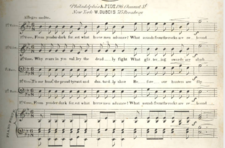
Chapel Hill, NC: Nineteenth-Century American Sheet Music
Website: Nineteenth-Century American Sheet Music (NcASM)
This University of North Carolina website holds more than 3,500 digitized pieces from the 1830s through the end of the nineteenth century. Accompanying catalogue records support searches by topic as well as composer. Holdings range from piano pieces and songs with piano accompaniment to duets, trios, and four-part glees. Miscellaneous material that forms part of the collection includes letters.
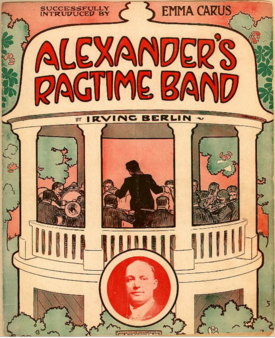
Durham, NC: Historic American Sheet Music
Website: Historic American Sheet Music (HASM)
Duke University's Historic American Sheet Music collection (3,000+ titles) spans the time-period 1850-1920. It includes a song-lyrics index, has tabbed browsing, and provides helpful background on the sheet-music printing industry in the US. HASM is also linked to the Library of Congress's American Memory project. It has particular value for matching references in early film music, ragtime, and piano-rolls, that is for repertories that were known principally by ear. Searchable by subject, instrumentation, and illustrator as well as more usual parameters.
Musical Repertories: Digitized Manuscripts
By Composer
Ludwig van Beethoven
Website (Bonn): Beethoven Haus, Bonn
The digital archives at the Beethoven Haus, Bonn, contains manuscripts, sketches, letters, pictures, sample sound recordings, and much else. Beethoven lived here, and the physical museum also houses his instrument collection. A recently funded project involving the Beethoven-Haus and the Musikhochschule in Detmold will develop an ambitious "Beethoven Werkstaat" project taking viewers through the development of individual works by way of sketches and editions.
Michael Haydn
Website: Michael Haydn Manuscripts
181 titles from the Bavarian State Library. Many holdings contain numerous items. Heavy emphasis on liturgical music.
Gustav Mahler
Website: Mahler Autograph Manuscripts
30 volumes of autograph manuscripts by Gustav Mahler are housed in the Bavarian State Library (Munich). Offerings include Das Knaben Wuynderhorn, sketches for three symphonies, and Mahler's correspondence with Emil Hertzka.
Carl Orff
Website: Orff Autograph Manuscripts
This collection of manuscript materials (91 titles) documents the musical career of Carl Orff (1895-1982). It includes, Leider, stage works, modern arrangements of Monteverdi operas, and other materials. Because of continuing copyright restrictions, many items can be consulted only on site in the Bavarian State Library. Nonetheless the detailed listing is valuable in documenting the range of Orff's interests and activities.
Max Reger
Website: Reger Autograph Manuscripts
The music of Max Reger (1873-1916) occupies a unique place in the keyboard repertory of its time. His organ works are better known than his other music--concertos, Lieder, choral works, and a clarinet quintet. Forty titles are viewable here.
Richard Strauss
Website: Richard Strauss: Musical Autographs
Among these 84 titles are numerous sketches, fragmentary compositions, and Lieder. The originals are held in the Bavarian State Library.
Georg Josef Vogler
Website: Vogler Music Manuscripts
Abbe Vogler (1749-1814) left a substantial collection of manuscripts (75 titles) that include chamber and sacred music, concertos and symphonies, plus several items that relate to his opera Castor et Pollux.
Richard Wagner
Website: Richard Wagner: Notebooks, music manuscripts, and correspondence
This collection of unpublished materials from the archive of the Bavarian State Opera brings Wagner's goals and working habits into our midst. Under 170 rubrics it documents the composer's movements, collaborators, and evolving ideas about music and role of music in society. They also give a more rounded view of his range of interests than many published accounts.
Ermanno Wolf-Ferrari
Website: Manuscripts of Ermanno Wolf-Ferrari
Ermanno Wolf-Ferrari (1876-1948) followed the path of aspiring students of his time in examining the details of earlier composers' practices. This collection of his manuscripts (175 titles) includes transcriptions of keyboard works by J. S. Bach, sketches of operas, concertos, symphonies, comic operas, a passion, sonatas, string quartets, and other chamber music.
By Collection
Music Manuscripts in the Bavarian State Library
Website: Music Manuscripts in the Bavarian State Library
This rich collection of 2228 digitized manuscripts is well endowed with music of the eighteenth and nineteenth centuries. Sample holdings include Alessandro Scarlatti's Missa Clementina, Antonio Caldara's sacred cantata "Gesu Cristo condannato", sacred vocal music by Michaelk Haydn, Handel's Deidamia, Karl Ditters von Dittersdorf, Dallapiccola, stage works by Richard Strauss, manuscripts of Carl Orff, and much other music.
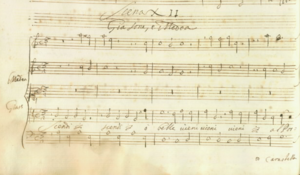
Music Manuscripts in the Marciana Library
Website: Music Manuscripts in the Marciana Library
The "library of St. Mark" (Venice) holds acquisitions that have been accumulating since the sixteenth century. Following guidelines widely shared across music libraries in Italy, it has digitized music manuscripts that are most closely tied to Venice's musical history. These include many important sources for seventeenth-century Venetian opera (Francesco Cavalli, Domenico Freschi, Giovanni Legrenzi, Carlo Pallavicino, P.A. and M.A. Ziani, and many others); 66 volumes containing cantatas of the eighteenth century by Benedetto Marcello (445 titles) and his nemisis Antonio Lotti, minuets by Baldassare Galuppi, and all the keyboard sonatas of Domenico Scarlatti (357 titles; his familiarity with Venice was minimal). Operas can be accessed by act.
Printed Music in the Bavarian State Library
Website: Printed Music in the Bavarian State Library
This collection of 3251 titles includes a large number of works from te eighteenth and early nineteenth centuries (Krebs, Türk, Korkel, Danzi, Mendelssohn, and others). It also holds impressive early printed music, including Pierre Attaingnant's seminal collection of Trente chansons musicales, use of which is restricted to study. Clemens non Papa, Croce, Lassus, Rore, Vecchi, Wert, and Willaert are much in evidence, as are the publications of Pierre Phalèse.
By Repertory
Cantigas Medievais Galegos-Portuguesas
Website: Medieval Cantigas
This website provides links to collections of manuscripts containing cantigas of Gallic and Portuguese origin. Many are preserved in the Vatican Library. The contents of each source is indexed, with full texts given in many cases. A sample folio is shown for each source.
Musica restaurata
Website: Musica restaurata
Illuminated manuscripts associated with the Low Countries in the Vatican Library can be viewed in high resolution owing to the generous support of the Alamire Foundation (Leuven, Belgium). The contents at the end of 2012 totaled 13,500 images.
Musical Repertories: Digitized Part-books and Choir Books
Early Music Anthologies
Bologna Partbooks (secular music)
Website: Bologna Partbooks
The holdings of the Biblioteca della Musica of Bologna are particularly rich in partbooks of of the sixteenth and seventeenth centuries. Among the 339 prints found here (served by the same library but originating in the Dipartimento di Musica e Spettacolo of the University of Bologna) many secular items and some sacred vocal music can be found.
Choir Books (mainly 16th century)
Website: Choir Books
Under the musical direction of Orlandi di Lasso the Bavarian court (Munich) reached a peak of activity much of which resulted in the development of a substantial collection of choir books. The layout of parts in a large-format choir book enables singers to see their parts while standing around the book. The origins of this tradition can be traced to c. 1400. The 199 choir books in this digitized collection contain sacred (Isaac, Josquin, Senfl) and secular music as well as fragmentary works and an anonymous Tractatus de musica. Holdings from local monasteries and private collections have been included.
Early Music Online
Website: Early Music Online
These 327 printed anthologies, held in the British Library (London), were originally microfilmed for the RISM AI project. Because of its heavy coverage of sixteenth-century prints (a high proportion of which were anthologies), it contains many real treasures--large numbers of madrigals, much of the early printed music for lute, and numerous prints in which almost all the works are by an important composer (Buus, Croce, Rore, Willaert. Seventy-seven volumes contains chansons. A smattering of treatises (Diruta's Il Transilvano, for example) can also be found here.
German chant and choir books
Webstie: German chant and choir books
This website serves mainly south German liturgical resources from the fifteenth century. It currently holds more than 200 items.
The Trent Codices (Fifteenth-Century Polyphony)
Website: The Trent Codices
This important collection of anonymous music of the fifteenth century is quite uniform in presentation, with most works employing a choir-book layout. Paper texture is well captured in the digitizations, which are highly consistent graphically. The number of titles is 1863. Few titles are attributed. Those that are come mainly from Guillaume Dufay (105 titles), Gilles Binchois (52), and John Dunstaple (30). The originals are preserved in the Castello di Buonconsiglio, Trent (IT).
Printed Polyphonic Works of the Sixteenth and Seventeenth Centuries
Website: Printed Polyphony of the 16th-17th Centuries
Similar to Early Music Online, but representing printed music in the Bavarian State Library and not limited to anthologies. It emphasizes music for voices. 1371 publication titles can be found. These include numerous early collections of chansons, madrigals, psalms, masses, motets, hymns, sacred songs, and early instrumental music (sonatas, balletti et al.). Titles in Latin, German, French, Italian, Spanish et al. Some items are of foreign origin (e.g. Purcell's Orpheus Brittanicus (London, 1698), Schmelzer's Arie per il balletto a cavallo (a horse ballet given for the wedding of emperor Leopold I and Princess Margherita of Spain, Vienna, 1667).
Databases (structured)
By Repertory
Secular Vocal and Folksong Repertories
CLORI: Archive of the Italian Cantata
Website: http://www.cantataitaliana.it/
CLORI, which hosts cantata texts, manuscript source citations, and images that show characteristics of handwriting, has a number of sponsors and collaborators including the Italian Musicological Society (SIM in Italian), the University of Rome (Tor Vergata), the Italian Institute for Music History (IISM), and RISM. The project is headed by Teresa M. Gialdroni. Click the "ricerca" button to go to the search form.
VolksLiedWerke (Austrian Folksong Database
Website: http://www.volksmusikdatenbank.at/
The VolksLiedWerke is assembled from collections originating in Austria's states. Search by title, personal name, or corporate name. Supported by the Austrian National Library (Öaut;sterreichische Nationalbibliothek) and other entities. Some regions have separate websites, such as this one for the Tyrol: http://www.volkslied.at/lieder/volksmusik-db.php, where scores and recordings may also be found.
Deutsche Volksiedarchiv (German Folksong Archive)
Website: http://www.dva.uni-freiburg.de/
The German Folk Music Archive (in German) has evolved over a century (to 2014) as a central clearing house for folk songs from German-speaking lands. It contains several component parts including (1) a Lieder lexicon in which folksong texts are listed alphabetically (http://www.liederlexikon.de/lieder); (2) a listing of specific projects, mainly those with a critical dimension (http://www.liederlexikon.de/ueber_liederlexikon_de/projekte); and (3) a popular-music Song Lexicon (http://www.songlexikon.de/).
English Broadside Ballad Archive
Website: http://ebba.english.ucsb.edu/
Six thousand English broadside ballads, mainly from the seventeenth century. A collaborative project that is still growing.
Old English Songs
Website: http://athena.uky.edu/oes/intro.htm
This collection, housed at the University of Kentucky, was once owned by the double-bass player Domenico Dragonetti. The contents mainly consist of opera arias (Handel, Bononcini, Purcell) and cantatas (rather than folksongs or sea shanties) in scanned images.
Recercar (Chanson Database)
Website: Catalog de la Chanson Francaise à la Renaissance
A search site with extensive metadata and musical incipits for a repertory of 10,000 works from the sixteenth century. Multiple settuings of the same text have individual listings (e.g. "Susanne un jour" currently has 26 listings). Works can be searched by title, scoring, composer, source, location, and text. Instrumental arrangements are originally texted pieces are included.Cross-referenced to comprehensive secondary sources and modern editions.
Goldberg Stiftung: Loire Valley Chanson Sources
Website: Chansonniers of the Loire Valley
The Goldberg Foundation has set up a system of hyperlinks to digitized resources for this subsector of the chanson repertory. As a collaborative project, it is somewhat uneven in its offerings. In compensation, comments can be appended to listings.
Sacred and Liturgical Music
Conductus: Online catalogue of poetry and musical settings
Website: http://catalogue.conductus.ac.uk/#m-columnbrowser@||m-informationcontrol@url=html/home.php
Content: Mark Everist's conductus cataogue, officially called CPI (Cantus pulcriorem invenire, contains 835 works found in 547 sources. It facilitates search by title, source, form, style of setting, stanza, poet, language, poetic structure (several subfields), and terminal accent. Sources listed are digitized and viewable online. Cross-listed to DIAMM and RISM.
Cantus Fractus Database (Raphael)
Website: http://www.cantusfractus.org/
An abiding problem in chant research is the evaluation of rhythm and proportion. This website (in Italian) by Marco Gozzi explores interpretative methods for repertories that are viewable online in early prints and manuscripts. A search form facilitates the retrieval of examples by source location.
Liber Usualis
Website: Liber Usualis
The Liber Usualis is the practical guide to chants for the Christian liturgical year. Although often considered to be ancient, it was first published in its present form in the middle of the nineteenth century. Some further accretions have occurred in recent decades. The Liber contains two cycles for the Christian year: one for the Ordinary (feasts whose liturgical needs are held in common) and one for the Proper of the Saints (feasts that are individualized in their liturgical requirements). Texts (in Latin) and music were widely paraphrased in liturgical music of the Renaissance. This version is searchable.
Mass Database
Website: http://www.mdb.uni-mainz.de/
Content: Records for c.40,000 settings of the Ordinary of the Mass from 1400 to the present day. In process of migration (March 2014).
Motet Database
Website: Motet Database
Guide to motets and Mass Propers in manuscript and printed sources from the period 1475-1600. 33,000 items, indexed section by section. Excludes Magnificats, Lamentation, canticle and strophic hymns. Extensive scribal and source detail.
Portuguese Early Music Database
Website: Portuguese Early Music Database
The Portuguese Early Music Database (PEM) is a model website in that it links Portuguese music manuscript listings with both RISM listings and CANTUS listings. The database is searchable by genre, feast, and composer. The holdings consist overwhelming of short sacred vocal works found sources that are extremely fragile and therefore well served by digitization.
Printed Sacred Music Database
Website: Printed Sacred Music Database
This collection of metadata and musical incipits (1500-1800) has been developed over decades under the direction of David Bryant at the Fondazione Giorgio Cini Onlus, Venice, with significant contributions by many individual scholars, and is now served at the Institute of Musicology, University of Fribourg (CH) and implemented by the Swiss RISM office. Search by composers, publishers, musical incipits, and much else. The musical incipits are encoded in DARMS and are rendered in mensural notation.
Medieval Music Database (MMD)
Website:Medieval Music Database
The original database, a model of integrated presentation combined with independent search of text and music fields, was developed by John Stinson and John Griffiths at LaTrobe University (Australia) between 1987 and 1999, when the university's music department was closed. It was maintained over the next five years by the University Library and is still accessible (2014) at the above link. Plans to bring it under the umbrella of DIAMM are under discussion.
One of MMD's great strength, for students of liturgy, is the ability to scroll bilaterally through the temporal and sanctoral cycles, that is by feasts of the Ordinary and those of the Proper. Many other search fields are supported including text, composer, genre, manuscript, and melody. MMD is cross-reference to the CAO database.
The musical examples in MMD were produced with Scribe software, also developed by Stinson and Griffiths (c. 1990). It encoded neumes and ligatures (mainly for 14th century music) for printing on a color deskjet printer. It was designed the DOS operating system and could export to the SCORE music-notation program.
RELICS (Renaissance Liturgical Imprints)
Website: RELICS: A Census
This database, hosted at the University of Michigan, contains entries on c. 14,000 sources of liturgical music printed through the year 1600. Started by David Crawford (1995) and continued by James Borders, the database is contains entries from publications in Grance, Germany, and many other European countries. Coverage extends to multiple Roman Catholic rites and to Protestant and Jewish liturgies.
Instrumental Music
Classical String Quartets
Website: http://library.duke.edu/digitalcollections/quartets/
Content: Duke University's Classical String Quartets website may not represent the largest collection of this repertory, but it is the largest collection of digitized prints currently accessible online. Its contents are characterized as "rare and unusual" rather than mainstream. If you are looking for variety, consider Förster, Gassmann, Pixis, or Wranitsky (a small sampling of composers represented).
Instrument Makers
Liuteria Bresciana
Website: Brescian Instrument Makers

Brescia was the first home of violin-making. So many of the early makers died in the plague of 1630-31 that Brescia was unable to regain its former glory. It exerted considerable influence on instrument-making in nearby Cremona, which flourished after 1650. Ugo Ravasio's website (Liuteria Bresciana, which covers the period from 1550 into until the eighteenth century, mainly emphasizes the pre-1630 period.
National Music Museum
Website: National Music Museum
The National Music Museum (Vermilion, South Dakota, US) possesses a highly diverse collection of instruments. It also houses a program on instrument conservation. The main components of the collections are (1) the Witten-Rawlins collection of Northern Italian (Brescian-Cremonese) strings from the seventeenth century, (2) an extensive group of instruments manufactured in the US in the nineteenth and twentieth centuries, and (3) a substantial collection of instruments from other parts of the world. The NMM provides links to many other little-known collections.
Composer/Theorist Documentation
Bach Digital
Website:Bach Digital
Bach Digital, based in Leipzig, is a one-stop shop for a catalogue of work by J.S. Bach (BWV); of scanned manuscripts; and of a database of manuscripts associated with the Bach family. When complete, it is intended to serve a wide variety of needs of scholars and interests of a wider music audience.
Handel Reference Database
Website: Handel Reference Database
The Handel Reference Database (HRD) provides a continuously updated version of the documentation that accompanied his Stanford doctoral thesis on the reception of the music of G. Fr. Handel.
Mozart Documents
Website: New Documents
The aim of this collaborative project is to bring documentation not reported in musicological literature to public attention. Some items have been retrieved from large repositories of digitized text.
Schenker Documents Online
Website: Schenker Documents Online
Schenker Documents Online (Southampton University) provides a scholarly edition of Heinrich Schenker's correspondence, teaching notes, translations of materials in German, and to show the gestation and development of his ideas. It concentrates on the period 1925-1930.
Works of Ludwig Senfl
Website: http://www.senflonline.com/
The most important composer in Bavaria in the first half of the sixteenth century, Ludwig Senfl (c. 1490-1543) spent almost all his life in the Munich court chapel, first as choirboy, then as musician and composer. Polyphonic incipits in mensural notation are among the items that can be retrieved by genre, voicing, and so forth. Cross-linked to DIAMM.
Giuseppe Verdi: Correspondence
Website: [1] Verdi Correspondence
This collection of 63 letters (1869-1883) especially concerns the countess Clara Maffei and Verdi's wife, Giuseppina Strepponi.
Braidense National Library
Website: Verdi Correspondence (Braidense Library)
For the Verdi centenary in 2013 the Braidense National Library in Milan digitized 76 letters written by the composer between 1838 and 1883.
Ricordi Historical Archives
Website: Ricordi Archives: Verdi Correspondence and Memorabilia
This great bulk of items in this miscellany (1786 of 2092), which includes corrspondence, scenary designs, pertains to Verdi and his dealings with Giovanni, Tito, and Giulio Ricordi, deals with librettists, casting, staging, and other production details, 1849-1893. One letter (1897) is from Giacomo Puccini.
Digitized Manuscripts and Early Printed Music
Danish National Sheet Music Archive
Website: Danish National Sheet Music Archive
The Danish National Sheet Music Archive is a model operation. Note the frame at the left, which identifies all digitized music; a special collection for flute; another for guitar; and the entire Carl Nielsen Edition available for download. Although Danish music is well served, the site includes a great deal more, including eighteenth-century manuscript, standard repertory in high-quality late nineteenth-century prints, and a special theater collection (libretti et al.).
Early Music Online
Website: Early Music Online
Early Music Online is a digital repository of music in printed anthologies principally from the sixteenth century. Based on holdings in the British Library and related to one series of RISM listings, the digitized volumes OF EMO include madrigals, sacred songs, music "concerted by voices and instruments," and pedagogical works.
National Library of Scotland
Website: National Library of Scotland
These digitized sources consist of diverse materials--memoirs, lyrics to Scottish folksongs, musical magazines, and Scottish keyboard music.--in multiple collections and viewing modes.
Online Thematic Indices
Benjamin Britten Thematic Catalogue
Website: Benjamin Britten Thematic Catalogue
The Britten Thematic Catalogue, an online only project based at the Britten-Pears Foundation, provides multiple access points for searching. Britten's career was extremely wide-ranging. His arrangements of music by Henry Purcell (54 titles) and of British folksongs (74 titles) filled much of his time in the 1940s and early 50s. The full gamut stretches from chamber music (134 items) mainly from the 1920s to his stage work Death in Venice (1973). Each work contains a detailed index with a graphical display and sound files.
Frescobaldi Online Thematic Catalogue
Website: Frescobaldi Online Thematic Catalogue
This database has a multi-faceted search interface. It is cross-linked to RISM IDs and has detailed source listings. (Content tends to vary slightly by source.) The general time-frame indicator gives a sense of the long tradition of recopying that followed the composer's works. Links to printed commentaries and modern editions are provided. Currently 906 works are included.
Digital Image Archives
Digital Image Archives of Medieval Music
Website: DIAMM
Originally a site for viewing images of rare manuscripts at various levels of resolution, DIAMM is increasingly an umbrella site for diverse projects in medieval music. The core textual database is organized by source location. Registered users may add their own comments about individual works. List and faceted search capabilities are currently being added. Now includes an online teaching resource for musicians wishing to learn more about the notation of medieval music. Register at http://diamm.nsms.ox.ac.uk/moodle/.
Emblematica Online
Website: Emblematica Online
This umbrella project serves a growing number of library-based projects, which are here cited individually. Emblem books are rich resources for those interested in decoding visual information in early printed materials. The collective site currently (April 2014) lists 636 emblem books. Searches by title, text, and image are supported.
Herzog August Bibliothek (HAB)
The http://emblematica.grainger.illinois.edu/Browse/Books/DigitizedBooksByTitle?instit=Emblematica%20Online Herzog August Bibliothek] in Wolffenbuettel[xx]makes available 636 emblems books, principally from the 17th and 18th centuries.
University of Illinois
Germans sources figure prominently among the 351 books at the University of Illinois emblem site i is cross-linked to one at the University of Illinois.
French Emblems at Glasgow
Website: French Emblems at Glascow
Contents: This site hosts 27 browsable emblem books associated with 16th-century France. Eack book islinked to an alphabetical listing by author that enables rapid exploration. Some sources are bilaterally in Latin. A smaller collection of Italian emblem books is also held.
Rare Music Manuscripts in the British Library
Website: Rare Music Manuscripts in the British Library
Content: See the Old Hall manuscript, Purcell's coronation anthem for James II, an excerpt from Handel's Messiah, Bach's autograph for Book Two of the Well-Tempered Clavier, Mozart's thematic catalogue of his composition, Beethoven's sketches for the Sixth Symphony ("Pastoral"), and much else. (Music manscripts make up just one part of the holdings viewable at this portal.)
Musica Sacra
Website:http://musicasacra.com
Content: notable collection of scanned chant books at http://musicasacra.com/music/ and http://musicasacra.com/resource-lists/. Includes the Liber Usualis and many other resources for modern use in traditional settings.
Resources for Chronology
Hofmeister XIX
Website: Hofmeister XIX
Content: Database of 330,000 records from the Hofmeister Monatsberichte, 1829-1900, listing music publications of the period. Compiled by Friedrich Hofmeister and published in Leipzig by Breitkopf & Härtel. Well indexed for quick searches.
Libretto Portals
Corniani-Algarotti Collection
Website: Corniana-Algarotti Libretto Collection
Although the search form shows only four fields, the name field (nome) will accept almost any proper noun (surname of composer, librettist, scenographer, city, theater, etc.). Most sources are digitized and downloadable. This collection holds 9,000 libretti (in Italian) from the sixteenth through the nineteenth centuries. Some were published and used outside Italy. Most texts were for operas, but oratorio, cantata, and serenata texts can also be found.
VifaMusik Libretto Portal
Website: http://libretti.digitale-sammlungen.de/de/fs1/start/static.html
The new (2014) VifaMusik Libretto Portal searches across component collections held in the Bavarian State Library (5600 items), the Frankfurt University Library, and the Library of the German Institute in Rome (1500 titles). One can search by composer, librettist, and so forth. Since the term libretto referred to any small book, texts for oratorios, cantatas, serenatas, ballets, and so forth occur in some of the constituent collections.
Index to Opera and Ballet Sources Online
Website: Index to Opera and Ballet Sources Online
This title index for individual works relies on aggregators (the Braidense Raccolta Drammatica, ViFaMusik, the Internet Culturale, et al.) for most of its contents. Since it does not distinguish between different versions of single titles, those with an acute interest in a defined topic may still wish to consult the aggregations. It relies on five data fields: title, composer, genre, format, and date. Its principal holdings are libretti. Some links to scores can also be found. The advance search tool at atom.lib.byu.edu/opbs/advanced allows one to search with individual aggregations.
Digitized Music Bibliographies
Eitner's Quellen-Lexikon
Website: Eitner's Quellen-Lexikon
Robert Eitner's Quellen-Lexikon, published by Breitkopf & Härtel between 1900 nand 1904, was the Bible for generations of scholars seeking to determine which libraries held surviving manuscripts of music from the sixteenth and seventeenth centuries. Although a portion of these sources are gradually finding their way online, Eitner remains an invaluable record of what sources existed before 1914. The scanned material was proofreading and corrected prior to posting. This site is hosted by the Musicology Institute of the University of Zurich.
Portals and Search Engines for Music
Europeana: Search Engine for European (Music) Sources
Website: http://www.europeana.eu
This umbrella site for European digitization projects covers a great deal besides music. To start, limit the search by an obvious word for music (musique, musica, Musik, etc.). This will give you an idea of how to further limit the search. Europeana is updated often. Among the items that should be visible are music prints, manuscripts, newspapers dedicated to music, sheet-music, audio files, etc. Since Europeana is an aggregation, it provides links back to the sponsoring libraries that hold the original sources. The site can be searched in many languages.
The Internet Culturale
Website: Internet Culturale
An umbrella site for digitized materials in Italian libraries. The riches of Italy's collective Internet Culturale (cultural internet) are difficult to overstate. A vast span of different kinds of graphically reproduced material will be found here. All of it is accompanied by generous supplies of metadata from cataloguing records. While one may be able to find a specific item (e.g. an aria), one may also discover on a different spoke of the site a long list of all the works in which the singer of aria appeared. Users can create accounts to keep previous discoveries collected in one place.
Munich Digital Manuscript Collection
Website: Munich Digital Library Manuscripts
The collection of digital materials grows so rapidly that any listing of individual collections within it is doomed to be inadequate. Several project are cooperative. The historical emphasis is on Middle Ages and Renaissance, with much emphasis on religious figures and documents (e.g. at Europeana Regia). A combined search engine (http://www.digital.collections.de) for all the digitized materials in the Bavarian State Library is currently under development.
Peachnote Music n-Gram Viewer
Website: Peachnote n-Gram Viewer
MIDI-based search by string.
Themefinder: Music-Incipit Search
Website: http://www.themefinder.org
Related literature: "Search-Effectiveness Measures for Symbolic Music Queries inVery Large Databases" (Craig Stuart Sapp, Yi-Wen Liu, and Eleanor Selfridge-Field)
The Themefinder search engine was prototyped at CCARH in 1996 by David Huron, Andreas Kornstädt, and Walter B. Hewlett. A large number of Stanford University students including Unjung Kim and Leigh VanHandel plus visiting students including Bret Aarden, participated in its early development. The search engine was originally developed to study user behavior. Over the intervening years it has been used for a large statistical study of search-efficiency. The current search engine is by Craig Stuart Sapp.
Themefinder contains several repertories, most of which are publicly viewable and searchable. The principal repertories are Folk, Classical, and Renaissance. Although more than 100,000 incipits and associated metadata are present in the database, users may select just one. "Hits" satisfying search-criteria can be collected on the Themefinder Clipboard and can be exported.
Incipits can be searched at five points on a continuing from the most specific to the fuzziest. Filter for meter, mode, and key may be used. MIDI files are available for each entry. Help menus area available at the website. Those interested in contributing an encoded repertory to Themefinder should describe the existing repertory and format in a query letter.
Music Theory Resources
Early Music Theory
Website: Early Music Theory
Illustration of the Sixth Rule from De imperfectionum notarum musicalium.
Early Music Theory subsumes the new digital edition of the works of Johannes Tinctoris. Twelve treatises are listed on the earlier Stoa site, and three are viewable.
Monuments of Partimenti
Website: Monuments of Partimenti
Robert Gjerdingen's online website for partimenti introduces the basic approach to improvisation and composition based on suggestive figured-bass sketches that survive, according to the seminal work of Giorgio Sanguinetti's The Art of Partimento (2012), in abundance from the eighteenth century. The website is still under development, but between the materials available here and the companion site linked to the book (above), users can form an elementary notion of the practice.
Thesaurus Musicarum Latinarum
Website: Thesaurus Musicarum Latinarum
The TLG, based at Indiana University School of Music, was begun in 1990 and extensively developed by Thomas Mathiesen, with the collaboration of many scholars in the US and abroad. TML was one of the earliest databases (and likely to earliest in musicology) to be fully searchable in a single pass.
While this database is exclusively devoted to writings in Latin from antiquity to the seventeenth century, the rise of parallel efforts for digitizing the texts of music-theoretical writings in modern languages spawned several parallel efforts, which are now subsumed under the title CHTML (the Center for the History and Theory of Music Literature xx).
Giuliano Di Bacco, who now heads the project, is at work on new digital approaches to presenting and searching the material.
Thesaurus Musicarum Italicarum
Website: Thesaurus Musicarum Italicarum
Frans Wiering's Thesaurus Musicarum Italicarum, which is entirely separate from the TLG, representeda second incarnation of his CD-ROM encodings of all the treatises of Gioseffe Zarlino (1995). The CD offered all the musical examples as MIDI and DARMS files as well as modern notation. Its viability was undermined by the evolution of operating systems in the early 2000s. Other works of Italian music theory from the decades following Zarlino were encoded subsequentlyby students at Utrecht University.
German writings on music theory and institutions
Website: Writings on Music Theory
This digitized collection (176 titles) from the Bavarian State Library emphasizes works printed between 1516 (Glareanus, Basel) and 1900. It includes a number of books related to individual theaters (mainly German).
Historical Maps
British Historical Maps
Website: http://www.nationalarchives.gov.uk/maps/
The National Archives (UK) hosts a large collection of maps and also has links to parallel materials with similar content.
David Rumsey Map Collection
Website: http://www.davidrumsey.com
Contents: 18th and19th century maps of the Americas. All maps are geo-encoded to facilitate geo-spatial and past-time applications.
Perry-Castañeda Historical Maps
Website: http://www.lib.utexas.edu/maps/historical/index.html
Notable for its spatial and historical spread and the detail with which the maps are specified chronologically. Many sources are scanned from maps printed in then nineteenth (or earlier) century.
Newspapers
ANNO
Wesbite: Historical Austrian Periodicals and Newspapers
Newspapers were published in Austria on Wednesdays and Saturdays. Readers will be grateful for the calendars that introduce each year of the collection (e.g. for 1705) and also for the thumbnails of each page of every issue. Almost a century (1606-1703) remains to be added. The overall range is from 1568 to today.
"Chracas" Digitale: Il Diario di Roma
Website: Chracas Digitale
This "diary" of news flowing into Rome from all over Europe was introduced as the Diario d'Ungheria [the Diary of Hungary] in 1716. It followed the earlier pattern of weekly avvisi that reported military news. That model was soon replaced (1718) by the more culturally oriented Diario ordinario. Under this title it rapidly gained readership. By 1721 it was publishing three issues a week. Most contain 12 pages. In 1799 the title changed to the Diario di Roma. Chracas remained its publisher until 1894. At present issues from 1716 to 1760 have been digitized by the Biblioteca Casasnatense, Rome.
The Gazzette Bolognese
Website: Gazzette Bolognesi
The Gazzette Bolognesi have intended parallels with the Diario di Roma. Bologna was historically a papal state. It gathered the same news and valued it similarly, though occasionally with less emphasis on the affairs of cardinals. Because of larger page size the Gazzette could convey more news from more places. (The Gazzette had only four pages per issue.) This fully digitized series runs from 1645 through 1796.
Music Magazines
Musical Magazines
Start site: Musical Gazzettes
Almost 25,000 musical magazines published in Italy before the first world war have been digitized by the Centro internazionale di ricerca sui periodici musicali (The International Center for Research on Musical Periodicals) in Parma. Among there holdings the most prolific were Milan's Gazzetta Musicale di Milano, London's Musical Standard, and Paris's Revue et gazette musicale. The best way to find them from this start site is to use the filters for language and date of publication at the left.
The Phonographic Newspaper
Website: Phonographische Zeitschrift
The Photographische Zeitschrift (Phonographic Newspaper) was published on poor-quality paper from 1900 to 1938. It was subtitled "a fact sheet for the music- and speech-making industry". This site is under development (2014).
Other Resources of general interest
Digital Libraries Gateway
Website: http://international.loc.gov/intldl/find/digital_collaborations.html
This Library of Congress gateway for international projects gives an overview of collaborative projects with an American component and currently including Brazil, France, the Netherlands, and Siberia.
Digital Scriptorium
Website:http://bancroft.berkeley.edu/digitalscriptorium/
Image database of medieval and renaissance manuscripts. Based at the University of California, Berkeley, it includes holdings from many US libraries, with extensive folio-specific information about each source.
Index of Christian Art
Website: ica1.princeton.edu/
One hundred twenty thousand (120,000) images from public and private collections in the English-speaking world plus additional indicies; roughly 100,000 are available to public via fee-sbased institutional subscriptions. Holdings from early centuries of Christianity to 1550.
Songs of the Niebelungen
Website: Das Niebelungenlied
These poetic texts, considered to date from before 1280, display settings of the legends that inspired Richard Wagner. As is characteristic of those resources preserved for posterity in this period, the script is very carefully prepared, the vellum on which it is preserved obviously sturdy. Each Lied is illuminated by a carmine letter. The texts mention Sifriden (Siegfried), Prvnhilde (Brunhilde), Gvnther (Gunther), and others. The illustration shows the first three stanzas of "Wie Gvnther Sifriden zvo der hohzit bat" (No. 12 of 39). Later portions of the source contain religious songs (Klage).
Rousseau Online
Website: Rousseau Online: Contents
Rousseau's writings contain countless items of interest. Here you can find the text of Pygmalion, Rousseau's Essay on Modern Music, his letters on Charles Burney and Mmessieur Raynal, the Dictionnaire de la Musique, and a host of miscellaneous writings from all periods of his life. The script is modern. ePub and PDF formats are both supported.
Watermarks
Watermark examination provides a fundamental (analogue) method of sorting and ordering materials that are undated or lack a provenance. They are especially useful in manuscript studies but can also play a role in the study of print traditions. The combination of digital photography and tools for photographic editing can be combined with extensive existing research on paper-makers to shed new light on musical sources.
Bologna
Website: Filigrane bolognesi, 1700-1800
Bologna was an important center for printing in early modern Italy. Roughly 100 paper types are identified here.
